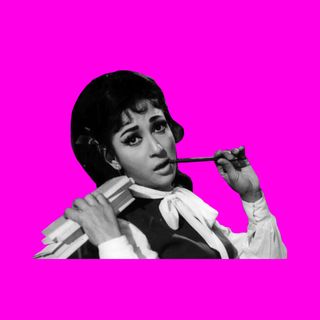
'Animal' Is Feminist Rage-Bait
Critique fatigue got us here.

The zeitgeist is tired of the post-Arjun Reddy discourse – criticism of films as misogynistic, sexist, or other buzzwords characteristic of a particular genre of feminist film criticism. It’s a fatigue that many filmmakers are beginning to slowly express, particularly in the wake of mid-2010s tongue-in-cheek critiques of 20th century Bollywood classics which had varying shades of troubling gender politics. Anjali from Kuch Kuch Hota Hai was a pick-me, the consensus now stated; Kabhi Khushi Kabhi Gham reinforced patriarchal family traditionalism; Bunny from Yeh Jawaani Hai Deewani was a fuckboy; Ved from Tamasha was a manchild; Raj from Dilwale Dulhania Le Jayenge was a creep, and on it went. It was getting tiring.
And then, there was Arjun Reddy, which amped it up to a fever pitch. The others had the benefit of hindsight; this film, on the other hand, marked the arrival of new-age misogyny. And this time, there was no excuse. Everyone in the newly-awakened woke millennial Internet age stood up in arms against the film’s premise that true love is violent, because violence signifies passion. That’s how, after all, Sandeep Reddy Vanga justified the film’s hero slapping his girlfriend.
Cut to 2023, more than half a decade later. Vanga promised that Animal, his Ranbir Kapoor-starrer magnum opus, would be even more violent than Kabir Singh (the Hindi remake of Arjun Reddy starring Shahid Kapoor). We should have heeded his warning. But then again, in a culture tired of the same old criticism about films being ideologically imperfect, would it have made a difference?
Animal, starring Ranbir Kapoor as Rannvijay, and Rashmika Mandanna as Geetanjali, feels like a spiteful response to feminist film criticism. It seems to exist to say: feminists don’t inherently get cinema; they (we) made irrelevant criticism, and thanks to Vanga, films with real passion (read: violence, according to his philosophy) are back. Animal tries to change the terms of the conversation about films: it challenges us to find technical faults with the film. Because technique and storytelling, in Vanga’s universe, are what really count as knowledgeable, informed criticism of the craft of cinema. Politics are secondary – if at all.
For one, the film constantly tries to posture the hero as an “alpha,” in increasingly unsubtle ways. It comes off more as a way to incite a reaction than to tell a story. But as a result, it seems to say: you can’t criticize the film for this, because you’d be outing yourself as a sensitive “snowflake.” In this narrative, only “alphas” get it. A film that is almost structured like a trap, Vanga not only encourages criticism, but seems to actively want it. Almost to get a rise out of feminists he knows will inevitably watch what he has to say.
The film, like its lead characters, treats nuance like it’s for “beta cucks,” as the MRAs would say. The message is loud, clear and more or less pushed down the throat. This – choking, shooting at, hitting, and betraying women – is just what tough men do. There’s an argument to be made for the fact that this is a film with an anti-hero, and that Rannvijay’s character isn’t morally righteous, making his behavior towards others clearly morally flawed. But there’s an easy counter to that: a morally clear film knows the difference between centering an antagonist, and endorsing his antagonism.
If anybody went into the film wondering how Vanga’s self-professed philosophy of violence being natural in love features into this film, they’re in for a bit of an update. Where Arjun Reddy fixated on violent passion for a lover, Animal has its hero fixating on both a lover and his (absent) father. In fact, the former is almost born from the latter. It’s a tale as old as time – Shakespearean in its agelessness. As far as the father-son relationship is concerned, the film offers a glimmer of a fresh perspective. But then it takes ideas of unquestioning loyalty and unconditional love for their own sake, and draws them out into unconvincingly extreme heights. Rannvijay loves his largely absent father, and is tormented by this fact. So far, so good. Except, we don’t know why. Animal scarcely touches upon their fraught history, or the father’s (played by Anil Kapoor) own baggage. And yet, Rannvijay demands the same unconditional loyalty from his wife. We still don’t know why. Except he’ll break her engagement, kill hundreds of people, and cheat on her. But, that’s all okay because he loves her, right?
“You forgave me for murdering hundreds but you can’t forgive me for cheating?” he asks her, at one point. The logic seems infallible to him. He seduced another woman to get information about his father's killer. Why should loyalty to anyone else, even to his own wife, take precedence over his love for his Papa?
And it’s not like Rannvijay seems to respect the women in his family any more either, nor do they have any more agency. When his sister is bullied in school, he arrives all guns blazing – literally – to avenge her honor. The fact that this event was the last straw that led to him getting banished to a boarding school doesn’t make him regret it one bit. It makes total sense. They hit on our women, we hit – nay, murder – them. What “our” women have to say about it is unnecessary. That’s just how animals behave, the film tells us. After all, Rannvijay doesn’t “see” ghosts, he eats them.
One can only call Animal feminist rage-bait. Taking the bait invites knowing scorn. And so any critique of the film that refuses to acknowledge its sadistic gender politics risks reducing criticism itself into one that is anti-ideology. Vanga asks us to return to “purist” film criticism, based purely on the merits of craft, storytelling, and technique alone. It’s the film bro’s fantasy of being compared with Tarantino, Scorcese, Francis Ford Coppola, and other legendary filmmakers of our time – people whose art is appreciated on a technical level, and whose storytelling is regarded as universal, of the human condition. In Vanga’s universe, this is the human condition: violent, degrading, and inevitable.
Already, Animal is being called divisive. This is what Vanga wanted. Already, it’s being called “entertaining” – despite the minor problem of the pleasure it takes in inflicting abusive violence on women. The film asks to be evaluated for its own merit as a film, yet seems to have been made as a meta-response to Vanga’s own cultural position as a “divisive” director. It’s asking for the return to the hegemony of masculinist cinema, rejecting the smarminess and insincerity of “diversity equality and inclusion” brands of critique. This is an outright refusal to even try to engage. It is reactionary rather than forward-looking. It almost seems to say: “enough is enough.”
How did we get here? Progressive film criticism itself became smarmy: well-intentioned, but so convinced of its own righteousness that it left no room for gray. Somehow we ended up in an era of simplistic, listicle-friendly feminist criticism which flattened nuance. As Jarek Paul Ervin noted in Damage Magazine, “Contemporary takes can often be wildly incongruent with their subject matter, as when critics note that Oppenheimer fails to cast a nice light on the women scientists who helped build the most vile device in creation, or when Forrest Gump appears alongside the white-supremacist film Birth of a Nation on a list of ‘movies that haven’t aged well.’”
Hollow feminist criticism also gave us unconvincing “women empowerment” films which sacrificed earnestness and authenticity for the sake of feminist brownie points. Everything about this genre of films – which said they were trying to take women seriously – felt put-on, superficial, and paper-thin. Take Pink, which was a sexual assault legal drama named for a stereotypically feminine color and redeemed by a male savior; or Gulaab Gang, which was a semi-unrealistic revenge fantasy. In Veere Di Wedding, there was a version of post-feminist, neoliberal empowerment.
As a result: Vanga rejects all of it. But here’s where he runs into a paradox: Animal wasn’t primarily by driven storytelling and pure love for cinema, as he insists is the right way to approach films. It was made to incite his critics – thereby centering the very thing he insists should not be centered. Don’t take any women seriously, don’t take feminism seriously, and especially not feminist critique, seems to be the message –but the tonality is still oriented around proving a point to feminist critics.
The excessive violence, the gratuitous sadism, seem to stand in for what’s been missing in the movies: passion, raw emotion, unrestrained and uncomfortable expression. But once again, besides the general, impersonal violence for revenge; passion is expressed as deliberate and intentional violence predominantly directed at women. More specifically, in the form of choking a woman, holding a gun to her head, then shooting the wall behind her, all because she confronted you about cheating on her. The problem now is that any criticism of these particular aspects of the film will appear to prove Vanga’s point: that you don’t get the point of the film. And the critique itself is automatically rendered invalid.
So what exactly does informed film feminist criticism entail, such that it leaves room for flaws, different interpretations, and shades of gray? It’s not how Vanga has caricatured it. “As a feminist film critic, I’m more interested in the aesthetics of time and space in storytelling than I am in seeing simplistic movies about women who fight like men. I’m also less than interested in filmmakers who can’t imagine a strong female protagonist without the sacrifice of a male character,” Martha P. Nochimson told Jennifer Merin. MaryAnn Johanson, noting feminist criticism’s imperative to grapple with male dominance on and off-screen, acknowledges, “Yes, it’s possible for a feminist film critic to enjoy films that aren’t feminist and those that are problematic in their depiction, dismissal or erasure of women – if not, we’d have very few films to enjoy.”
That arguably explains why “problematic” films – like DDLJ, K3G, and several others from the early aughts – are still fondly remembered, engaged with, and treasured. And why Arjun Reddy, Animal, and anything else from the Sandeep Reddy Vanga Cinematic Universe of Feminist Rage-Bait, will not be.
Animal is Vanga’s anguished cry to the world: feminists are killjoys, and they’ve ruined the movies. Enough about the male gaze, enough about the delicate balancing act, no more walking on tiptoes – this movie is all guns blazing in its misogyny – and it dares you to call it misogynistic. And you know what? It is – but that isn’t why it’s a bad movie. It’s a bad movie because in its attempt to be a “gotcha” moment to feminist naysayers, it forgot to be a movie.
Related


Is This Normal? 'I Absolutely Can't Work Until The Last Minute'
